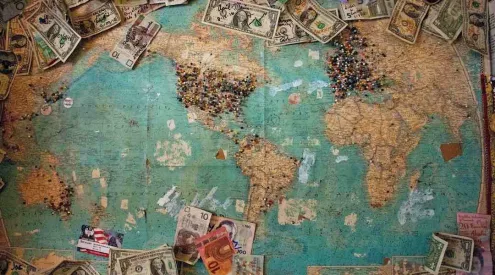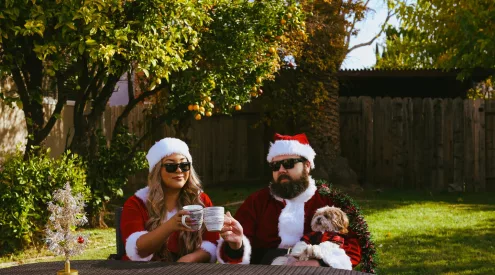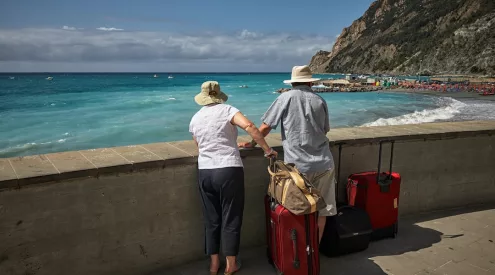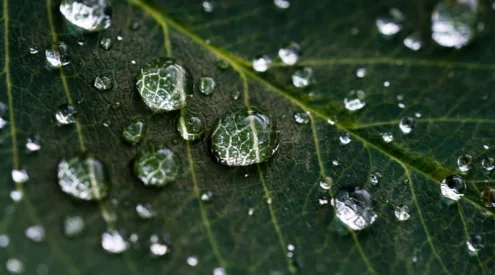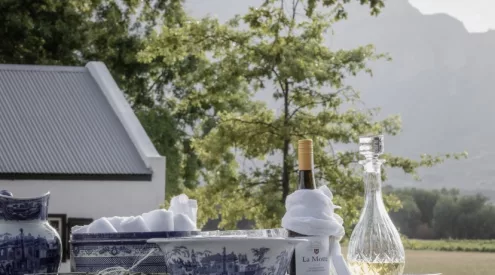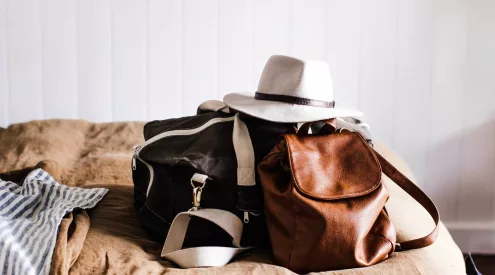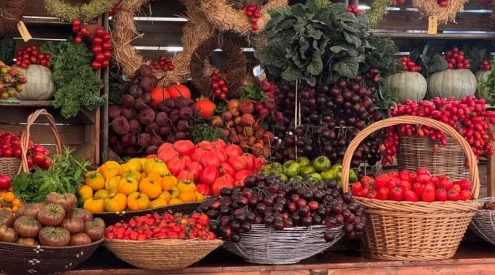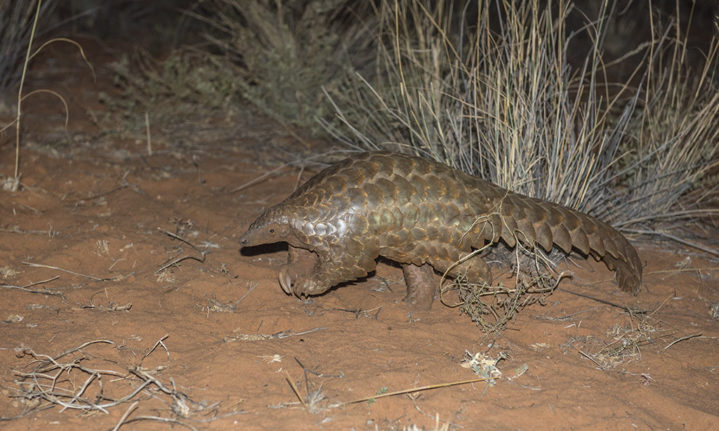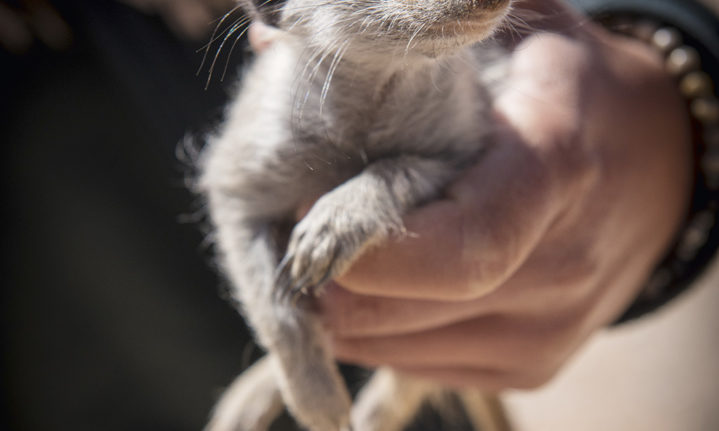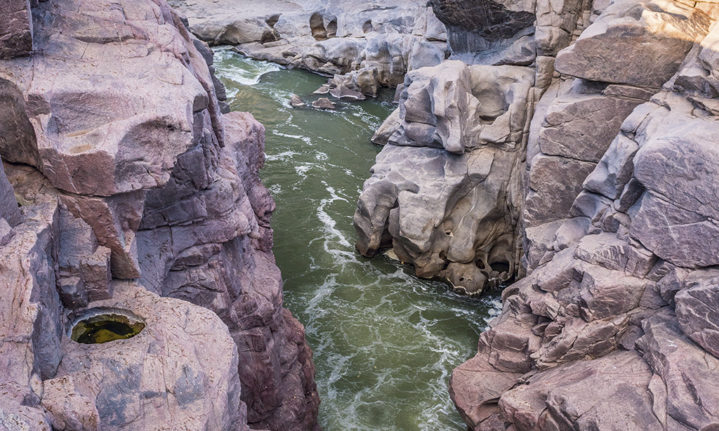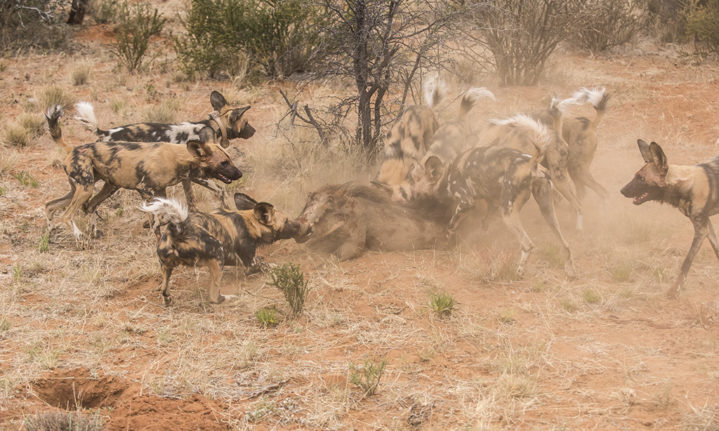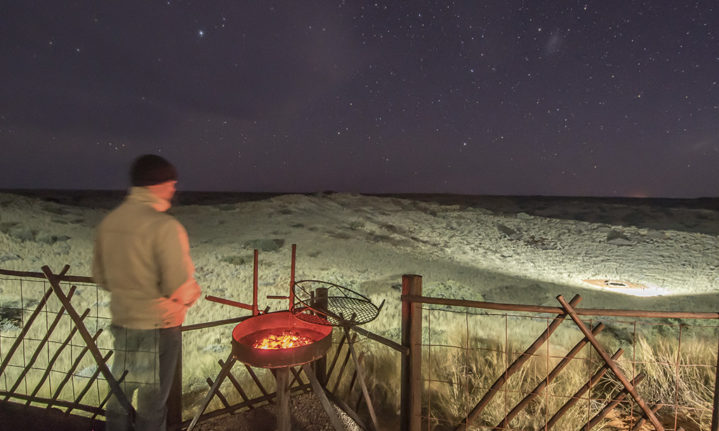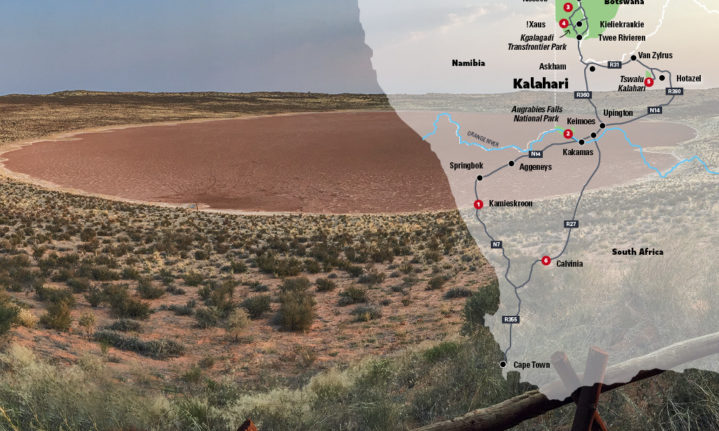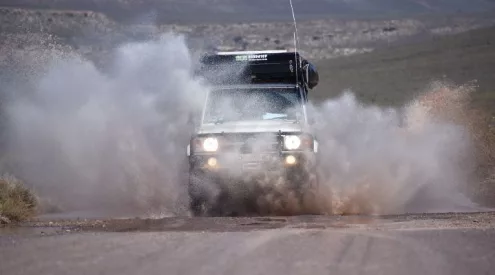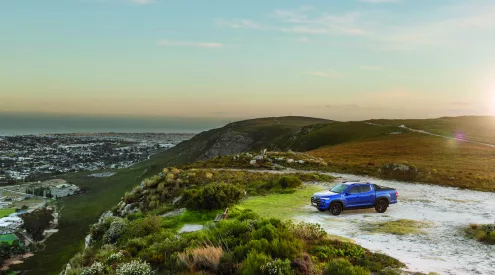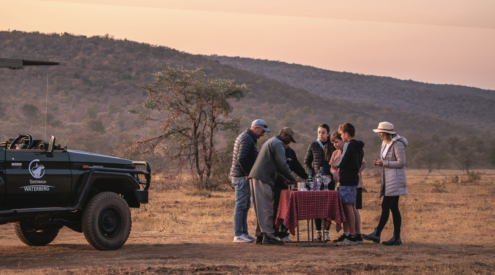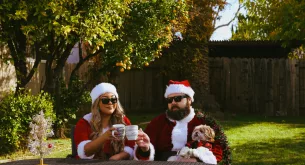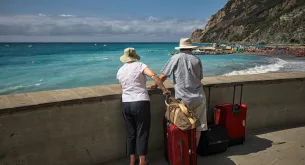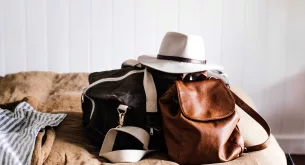The Kalahari is an elemental thirstland inhabited by strange, desert-adapted plants and animals. It’s the kind of place that draws you back again and again. On this road trip, we seek out the best that the South African Kalahari has to offer.

Red-dune sundowners in Tswalu Kalahari, South Africa’s largest private game reserve. Image credit: Justin Fox
Don’t let the brittle grass brush your trouser legs. The telemetry is telling us to climb the dune. So we do. But even my breathing seems too loud. Suddenly, there he is! The pangolin shuffles out from under a bush and pauses, just metres away. He emits a low purring, almost like an elephant’s rumble.
We stand in silence, spell- bound. A prehistoric wonder – a terrestrial crustacean seemingly pulled from the bottom of the ocean … or another planet. He moves on with a waddling gait, scales clicking, tongue probing at ant holes. We walk beside him for a while until he picks up speed and totters noisily into the night. This is a Kalahari scene that has hardly changed in 40-million years.
It was to be a 10-day road trip for two. Tracey Younghusband had packed the padkos and was sitting beside me with a map open on her lap. Table Mountain was shrinking in the rear-view mirror of our Ford Kuga and the N7 unspooled ahead of us. It was spring time, we were free of city grind at last and Kalahari bound. Johnny Clegg sang about African skies from our road-trip playlist as we passed Piketberg, then Clanwilliam and Garies, the land growing drier and Namaqualand daisies lining the road in swathes of incandescent colour.
We spent the night at the Kamieskroon Hotel, an old favourite with generations of Getaway journalists. Then we swung east on the N14 and into a landscape of endless wastes and pink mountains, past Pofadder and Kakamas to the thundering waters of Augrabies Falls.

A pangolin spotted at Tswalu. Image credit: Justin Fox
From our national-park chalet, we could hear the Orange River squeezing through a narrow groove and hurling itself into the gorge. The name derives from the Nama word !oukurubes (‘place of great noise’) and was a sacred spot. It brought considerable bounty to the inhabitants: hippos were swept over the falls, breaking their spines and providing enormous feasts; the bottom end of the gorge also offered good fishing where Khoikhoi cast their bone-hooked lines or set karee-wood fish traps.
We walked to the lip of a smooth rock that tipped into the abyss. The river turned from green to white as it shuffled through upstream rapids, poured through a spout, hit a ledge, and rocketed into the gorge. You can feel its wind and spray 300 metres away on the cliffs. My eye followed the water’s surgery below the falls as it carved an 18-kilometre canyon from pure granite. Around the edges, boulders the size of trucks were balanced on smaller ones, seemingly ready to topple at any moment.
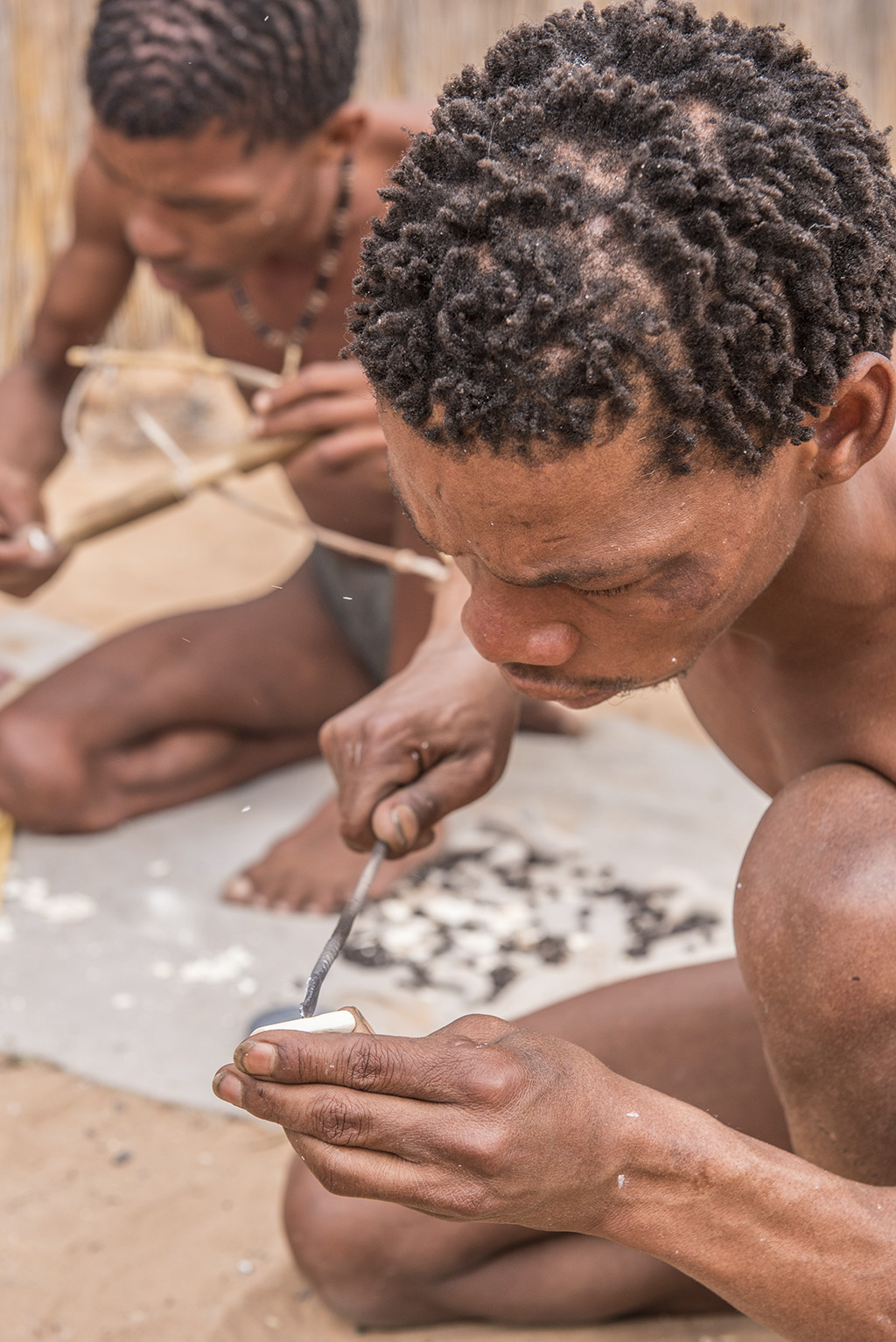
the ‡Khomani San demonstrate traditional jewellery making. Image credit: Justin Fox
East of the falls, the N14 follows the listless sweeping of the Orange and is lined with vineyards. Upington provided the last chance for a proper stock-up of food supplies before we struck north on the R360, the land turning itself slowly into a dune sea – real Kalahari. Reaching Twee Rivieren, we signed in at the main gate of Kgalagadi, Africa’s first transfrontier park. At 3,8-million hectares (twice the size of Kruger), this is one of the largest conservancies in the world. It has three main, fenced camps and six unfenced, wilderness camps. We headed straight for Kieliekrankie, my favourite of the latter. It has four ochre chalets on the crest of a dune overlooking a waterhole.
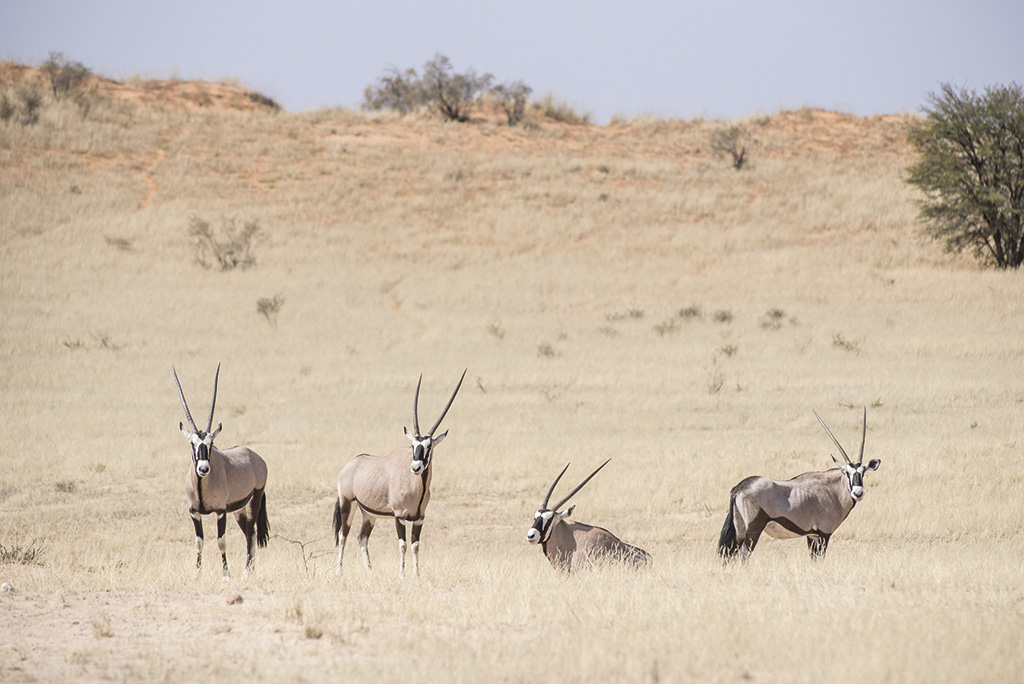
Gemsbok are the iconic painted warriors of the Kgalagadi Transfrontier Park. Image credit: Justin Fox
From there, our days were spent exploring the dry Auob riverbed whose waterholes provide for herds of springbok, wildebeest and gemsbok. Everywhere were meerkats, ground squirrels and yellow mongooses going about their bustling burrow business. Crimson-breasted shrikes looked like drops of blood in the camel thorn trees, while pale chanting goshawks and tawny eagles scanned the ground from lofty perches. Our mornings started at first light. It was freezing out – below zero – and we bundled up in layers.
We’d find a waterhole, out would come the coffee flask and rusks, and there we’d sit to await the action. Gusts of red-billed queleas and sandgrouse, turtle and Namaqua doves would descend to drink. There’d be lines of antelope, ostrich and the occasional, skittish giraffe. A herd of wildebeest would arrive at pace, their hooves creating explosions of gold dust against the rising sun. On one occasion, Tracey noticed scuffling beside the car and we peered down to find a Cape fox making renovations to its home.

An inquisitive baby meerkat at Kalahari Trails. Image credit: Justin Fox
Each evening we’d braai, because it’s the thing to do in the Kgalagadi and because it’s one of humankind’s greatest inventions. Two chops, a coil of wors, a workmanlike red wine and the stars for company. And oh my, those Kalahari stars. The brightness of them. The majesty. A jackal would cry, an owl would answer, barking geckoes chorused from their burrows. The night spoke on in deliciously unknowable tongues.
Our next stop was Nossob, where we stayed in one of the new, ‘river-front’ chalets. Like Twee Rivieren and Mata-Mata, Nossob is a bigger, fenced camp with a swimming pool, shop and lovely hide beside a busy waterhole. At dusk, the jackals arrived, tripping around the chalets searching for morsels. All through the night, creatures came and went like ghosts in the waterhole’s spotlights.

Augrabies Falls has, over the millennia, carved an 18-kilometre canyon. Image credit: Justin Fox
!Xaus lies on the park’s south-western fringe, a concession granted to two local communities (the Mier and the ‡Khomani San). In 2002, after a protracted land-claim settlement, 50,000 hectares was given back to these communities. We arrived at the lodge, which sits at the end of a 30-kilometre driveway through the dunes, and were met by manager Anthony Manley. Over a welcome drink, he told us how the lodge had stood empty for three years. ‘Government built this place, but no-one wanted to run it,’ he said. ‘It’s so remote and logistics are a nightmare. Transfrontier Parks Destinations (TFPD) stepped in and took it over.
This kind of challenge is our speciality. !Xaus has been a great success. The communities get paid rent and there’s decent profit share. What’s more, we’ve just been declared a Dark Sky Sanctuary, the second in Africa.’ The lodge comprises a series of chalets linked by raised walkways on the ridge of a dune. Stepping onto the deck, I was struck by the scene below. At the base of a sandy amphitheatre lay a beautiful saltpan in the shape of a heart. Its surface glowed pink in the late afternoon light.

Kieliekrankie Wilderness Camp has four lonely chalets on a dune overlooking a small waterhole. Image credit: Justin Fox
‘The spirit of the great heart,’ whispered Tracey. In the morning, tracker Corne Witbooi led us on a walk, single file, into the dunes. Somewhere to the south, a lion let out a reverberating roar. We veered north. Corne pointed out burrows, spoor and the dung of myriad creatures. ‘We read the sand like it’s a newspaper,’ he said. ‘With such hot summers and such cold winter nights, more than 80 per cent of the biomass is underground. We must look for the signs.’ Here the silk-lined trap of a buckspoor spider, there the paw prints of an aardwolf.
Corne told us the medicinal uses of plants we encountered – boil the leaves of the flu bush; use the three-thorn for stomach troubles. We came to a San encampment, set up by the community to give guests a taste of traditional ‡Khomani life. A small group clad in loincloths was busy crafting leather- and ostrich-eggshell jewellery. Normally I’m uncomfortable with such ersatz encounters, but knowing that the community had ownership of this project did make a difference. Corne led us back to the lodge via the pan. Its salty crust crunched underfoot.
Crows squawked overhead; clouds scudded by casting strange dapples; a lone gemsbok bisected the pan. This pink heart at the centre of Mier and ‡Khomani San territory was a place of magical enchantment. Next, we headed east to end our journey with a spot of desert luxury. We took the long, white-sand R31 from the Kgalagadi via Van Zylsrus to Tswalu Kalahari, the largest private game reserve in South Africa.
Owned by the Oppenheimer family and made up of former farms now ‘rewilded’, Tswalu is set in a stark landscape of red dunes, purple mountains and undulating grasslands. The main lodge, The Motse, lies at the foot of the Korannaberg mountains, facing west. The decor and design are some of the best you’ll see in any lodge. Each group of guests has their own vehicle, making for a very exclusive experience. Our game drives were led by ranger Chris Erasmus and tracker William Gaotsenwe. From the outset, we were rewarded with good sightings of black rhino, roan and sable antelope, red hartebeest and African wild cat up close. And there was the blessing of that night-time pangolin encounter. We also visited a meerkat colony.

This lioness – her belly full from a recent kill – approaches a Tswalu waterhole to slake her thirst. Image credit: Justin Fox
Researchers have habituated two groups and we were able to walk among them, listening to their noisy chatter and watch their frenetic interaction. One morning, we came upon three lionesses of the southern pride slaking their thirst at a waterhole after a kill. The cats ambled past our vehicle without giving us a glance. Nearby, we came upon their two black-maned companions – monstrous males, all muscle and arrogance – snoozing in the shade. On our last game drive, we tracked a pack of wild dogs that had been seen near camp. William soon found their spoor.
The dogs were moving through thick bush and we struggled to keep up, our 4×4 driving over bushes and bouncing through burrows in the process. Two kudu on a ridge spotted trouble and made off at pace. The dogs swung south, fanning out, then vanished. Chris drew to a halt and switched off the engine. Just then, there was a snort and a squeal. ‘They’ve denned a warthog!’ he shouted. ‘Do you want to see it? We don’t always go. Could be gory.’ I nodded and we took off in that direction.

A pack of wild dogs dragged this warthog from its den in Tswalu and devoured it in front of us. Image credit: Justin Fox
Rounding a bend, we found the painted hounds encircling a burrow, yipping excitedly as the pig tried to use its tusks in self defence. Dust and desperation. First blood. The battle lasted a dozen minutes, with the dogs taking turns to attack. Eventually the hog was dragged from its hole and the hounds tore at it, ripping flesh and tearing out intestines to a bloodcurdling scream that sounded human. Tracey and William looked away. I kept my finger on the Nikon’s trigger but felt the nausea and horror, and closed my eyes. Soon, there was nothing left of the pig.
We retreated to a waterhole, got out to stretch our legs and have a coffee. No one spoke. The pictures were too vivid, too livid. Later, driving the long road back to the Cape, I thought of both the horror and the privilege of that kill. It was nature’s claws at their reddest. But it was pure Kalahari. Although I knew I’d never look at dogs in quite the same way, not even a granny’s Pekinese.
About The Journey

We divided our 10-day road trip into relatively comfortable day drives:
Cape Town to Kamieskroon – 596km (6½ hrs)
Kamieskroon to Augrabies – 383km (4 hrs)
Augrabies to Kieliekrankie – 414km (6 hrs)
Kieliekrankie to Nossob – 118km (3½ hrs)
Nossob to !Xaus – 125km (3½ hrs)
!Xaus to Tswalu – 371km (6½ hrs)
Tswalu to Calvinia – 668km (8 hrs)
Calvinia to Cape Town – 381km (4½ hrs)

The heart-shaped pan at !Xaus is considered the epicentre of the ‡Khomani San and Mier ‘homeland’. Image credit: Justin Fox
About The Car

The Kalahari can be an unforgiving environment for vehicles. For our journey, I chose a Ford Kuga Titanium TDCi AWD. This stylish, agile vehicle performed well both on and off the blacktop. Its supple suspension, a hallmark of Fords, is augmented by steering that’s tight but responsive. For greater control in challenging conditions, the All-Wheel Drive system is designed to monitor the Kuga’s performance and continually adjusts the delivery of torque to each wheel. Our mixed route returned less than 8L to 100km – good enough for a range of more than 800km from its 60L tank. Starting from R384 900, the Kuga range is certainly good value for money for its class. ford.co.za
Recommended Books
– Kalahari Dreaming by Bernd Wasiolka
– Kgalagadi Self-Drive by Jaco Powell and Ingrid van den Berg
– A Natural History Guide to the Arid Kalahari by Gus and Margie Mills


